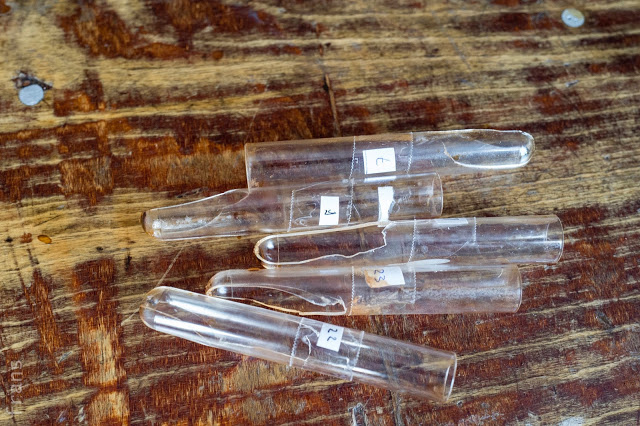
The recently launched Londinium Espresso Distribution Tool promises to reward you with a very high level of consistency to your espresso extractions. What is the effect of using the LDT? Does an espresso made with this tool taste better? Frans is doing a series of experiments of the tool in combination with different Compak Grinders. Blind tasting is a great way to measure the effect of the LDT but a downside of this method is that it’s very time consuming. One would need many samples tasted and compared. Also this method is not completely objective. The selection of the espresso tasters would influence the result of the experiment.
Londinium Distribution Tool in action
Frans and I wanted to get more objective data about the effect of the LDT. What does it do to the neatness of the flow (even/uneven), timing and extraction yield? To answer these questions we did 30 extractions from grinds from the Compak E5, on and off using and not using the LDT. So #1 not stirred and only shaken, #2 stirred and shaken, etc. We observed and noted the flow (even/uneven), the timing, and measured the Extraction using the centrifuge and VST refractometer.
All the espresso’s for this experiment were brewed using the Londinium R lever machine, an 18 grams VST Precision Filter Basket and the Londinium Dosing Funnel. For every shot we dosed exactly 18 grams to brew an espresso of 30 grams.
Marking of test tubes

30 Espresso’s in test tubes

Results
Our experiment wasn’t without problems or errors. First problem was that the extractions towards the end of the experiment got increasingly shorter in time. An explanation could be that the grinder behaves differently when it heats up during use. This made our samples less uniform than intended. Also the high speed centrifuge (3500 rpm) did make more noise than usually. This turned out to have been caused by the breakage of 5 test tubes which were of a lesser quality than the standard glass tubes we also used. We need to use these learnings to improve in case we decide to do a next experiment.
Broken test tubes

Regarding extraction yield: there were some measured differences but statistically these may have been likely caused by chance.
- The LDT did give us more consistent extraction percentage. This means that there was a narrower variation in extraction yield using the LDT
- The LDT also gave a significantly higher number of smooth, even flowing extractions. Especially the latter is often an indicator of a better tasting cup
- The more ‘sloppy’ extractions without LDT did show some higher extraction numbers but, as said above, not in a statistically relevant manner so we would need to test more if we’d want to pursue this further.
Below you can see the effect of the LDT on the neatness on the flow. Espressos made with the LDT had about 80 percent nice and balanced extractions. 27 Percent of the merely-shaken grinds had nice looking even extractions. That means that by using the Londinium Distribution tool we tripled ‘even and nice looking extractions’.

A statistical test showed us that this result is significant (p < 0.05). That means that it’s unlikely that a difference between the groups was caused by chance. Below you can see the result of the statistical test (Pearson’s Chi-squared) that was calculated with R Commander in RStudio

Conclusion
The LDT will give you a significantly higher number of smooth, even flowing extractions. Especially the latter is often an indicator of a better tasting cup. Regarding coffee extraction yield we did not find significant results. We would need to test more if we’d want to pursue this further. Read more about the Compak Grinders and Londinium Distribution Tool on Frans’ blog.
Leave a Reply
You must be logged in to post a comment.